Maximizing Your IR Microscope: Techniques for Improved Performance and Measurement
The author discusses how researchers can gain the most accurate and useful data from their equipment by employing careful sampling and microscope techniques and following a few common best practices.
Fourier transform–infrared spectroscopy (FT-IR) offers countless user benefits, including real-time data, multicomponent analysis, and compatibility with automated sampling and microsampling techniques. Types of IR microscope measurement techniques include transmission, reflection, and attenuated total reflectance (ATR). But with each of these, there are pitfalls as well as a number of best practices that will yield superior data. These measurement techniques and their respective analytical processes are described here to help you avoid common mistakes in IR measurement and get the maximum performance from your microscope.
Diamond cells or KBr or BaF2 window materials are often used for Fourier transform–infrared (FT-IR) transmission measurements, allowing for easy collection of infrared spectra. However, each of these requires great care to obtain good-quality spectra.
Transmission Methods
Diamond Cells
A diamond cell incorporates two cell plates that compress the sample. After compression, measurements are conducted on the sample adhered on a single cell plate. If measurements are conducted with both cell plates in place, an interference pattern is superimposed over the sample spectrum. Figure 1 shows analysis of caffeine powder using a diamond cell. The red line shows the spectrum of the sample on a single cell plate; the blue line shows the spectrum measured with the sample sandwiched between two cell plates.
Figure 1 shows that an interference pattern is superimposed over the sample spectrum measured using two cell plates, such that the baseline exceeds 100%. The interference pattern occurs due to the parallel space between the two diamond disks. Measurement conducted with two cell plates increases the noise near the 2000-cm–1 absorption band of the diamond. So, after a sample is crushed between the two cell plates, the sample adhered on a single cell plate is analyzed. Rubber and other elastic samples are exceptions to this rule and are measured while sandwiched between the two cell plates.

Figure 1
Sample Quantity
Only a trace sample is required for transmission measurement. Too much sample lowers the baseline and results in a spectrum with saturated peaks. Figure 2 shows an example of this using a caffeine powder sample. The red line shows the spectrum obtained with an appropriate sample volume; the green line is the spectrum for an excess of sample.

Figure 2
Excessive samples cannot be compressed sufficiently, so measurements must be conducted on thick film. This results in a spectrum that is difficult to analyze due to a lower or inclined baseline and saturated peaks, as shown by the green line in Figure 2. Therefore, the amount of sample must be adjusted to create a thin layer on the diamond cell.
Background Measurement and Sample Measurement Positions
The positions chosen for background measurement and sample measurement have an influence on the spectrum. Choosing a background measurement position as close as possible to the sample measurement position achieves a good spectrum with approximately 100% baseline.
Figure 3 shows the spectra for cellulose fiber obtained with background measured in a corner of the diamond cell (BKG1) and with background measured near the sample (BKG2). The amount of transmitted IR light differs between the edges and center of the diamond cell. The amount of IR light is lower if background is measured away from the center of the cell. In this case, sample measurements result in a spectrum with a baseline exceeding 100%. To avoid this, position the sample in the center of the diamond cell and measure the background as close to the sample as possible. If the sample is not in the center of the diamond cell, the background must also be measured near the actual sample position, away from the center of the cell.
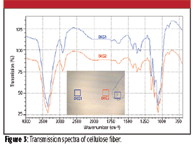
Figure 3
An interference pattern may appear on the baseline if it is measured on a smooth part of the sample surface. Figure 4 shows examples of polypropylene (PP) measurements. The insert shows a photograph of the actual measured positions. If an interference pattern appears on the baseline, it may hide small peaks.
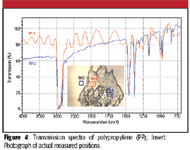
Figure 4
Using the Aperture
Do not increase the aperture if the foreign matter (sample) is relatively large. It is more effective to set the aperture to approximately 50 μm and measure the spectra at a variety of positions than to increase the aperture. Constant results at each measurement position indicate that the foreign matter is a single component or a uniform mixture. Sample identification and analysis by spectrum searching are possible on a spectrum not affected by peak saturation or an interference pattern.
However, differences apparent between the spectra indicate a nonuniform mixture of foreign matter. In this case, differential spectra are determined to obtain a spectrum for each component.

Figure 5
Figure 5 shows the measurement of foreign matter on the surface of paper. The aperture is set to 30 × 30 μm. The diagram shows a position of strong intensity near 1500 cm–1 (S-1) and a position of strong intensity near 1000 cm–1 (S-2). The position near 1000 cm–1 results from a normal component of paper (cellulose). Calculating the difference between the spectra from S-1 to S-2 in Figure 5 gives the spectrum for just the foreign matter. Figure 6 shows the resulting differential spectrum. Spectrum searching of the differential spectrum in Figure 6 indicated the foreign matter to be magnesium carbonate.
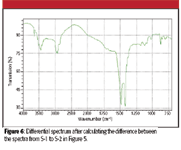
Figure 6
Reflection Method
The IR reflection method is extremely simple, requiring little to no sample preparation. However, measurements are limited to certain sample forms. One of the typical samples suited to microscope reflection measurement is a foreign matter adhering to a highly reflective substrate.
Analysis of a Thick Sample
The specular reflection from a thick object adhering to a metallic plate surface is about 5% of the total incident light. When a sample is thick enough, even if some light is reflected from the metal surface, almost zero light will be reflected from the sample surface. The specular reflectance spectrum obtained in Figure 7 displays a distortion in the first derivative spectrum due to a large change in the reflectance (refractive index abnormal diffusion) where strong absorption occurs. However, a spectrum similar to an absorption spectrum can be obtained by applying Kramers-Kronig (K-K) analysis.
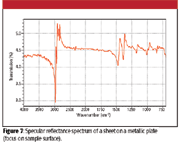
Figure 7
Typically, less light will reach the detector during a reflectance measurement with an IR microscope compared to a transmission instrument. The amount of light is markedly decreased, particularly when analyzing a thick sample in reflection mode, requiring considerable integration to improve the signal-to-noise ratio (S/N).
Figure 7 shows a measurement example of a glossy coating sheet (about 1 mm thick) on a metallic plate. Measurement was conducted by focusing on the sample surface and setting the aperture to 30 × 30 μm.
In Figure 7, the peak shows a distortion in the first derivative spectrum as described earlier, unlike that observed in a normal absorption spectrum. Figure 8 shows the result of applying K-K analysis to the spectrum of Figure 7. It is easy to determine from Figure 8 that the coating sheet is polypropylene.

Figure 8
Figure 9 illustrates the results of a measurement when focusing on the surface of the metallic plate, rather than the sample surface. It is evident that the peaks are saturated in the reflection absorption spectrum due to the thickness of the sample.
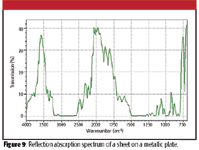
Figure 9
In this way, when the sample is thick, only the specular reflection spectrum can be obtained if the focus is on the sample surface, and qualitative analysis of the sample is possible by applying K-K analysis.
With samples like powders and fibers, which have rough surfaces, it is difficult to detect only specular reflection components from the sample surface because most of the light is diffused. When sampling is possible, the IR microscope transmission method is suitable, but when the target object is protruding from the surface, the IR microscope attenuated total reflectance (ATR) method is more applicable.
Anaylsis of a Thin Sample
Analysis of a thin object adhering to a metallic plate surface is illustrated in the schematic diagram of Figure 10. When the sample is thin, incident light is reflected from the surface of the metallic plate and exits. In this case, the spectrum obtained is a reflected absorption spectrum similar to that in transmission measurement when large amounts of light are reflected from the metal surface (blue line in Figure 10). A spectrum of pure specular reflection and reflection absorption is obtained when a small amount of light is reflected from the metal surface. This kind of mixed spectrum creates positive peak distortion (increased transmission) at the higher wavenumber side of the peak position. Conversely, negative distortion (reduced transmission) occurs at the lower wavenumber side. This characteristic is the same as the Christiansen effect seen when using the KBr pellet and Nujol mull methods. (Christiansen effect: A phenomenon in which the amount of transmitted light changes in the vicinity of the peak position due to the relationship between the refractive index and the reflective index. This often occurs with light-scattering samples.)
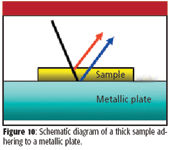
Figure 10
Figure 11 shows a measurement example using a thin sample. Measurement was conducted using a 20 × 20 μm aperture setting. Measurements 1 (red line) and 2 (blue line) show results obtained at different positions.

Figure 11
In measurement 1, a normal absorption spectrum is observed, but in measurement 2, peak distortion is seen in the vicinity of 1500 cm–1 . If this type of spectrum is obtained, it is necessary to search for a position that returns a spectrum similar to measurement 1 since the peak position and absorption intensity are different from the proper values. If the target object is extremely small and it is not possible to change the measurement position, use the IR microscope transmission or IR microscope ATR method to obtain an undistorted spectrum.
Background Measurement Position
The background and sample measurement positions have an influence on the spectrum in the IR microscope reflection method. Figures 12 and 13 show a sample analysis of an object adhering to a metal plate surface. Figure 13 shows the spectra obtained by background measurement at the two positions (BKG 1 and BKG 2), with the sample position fixed on the foreign matter on the plate.

Figure 12
In Figure 13, peaks are not as distinguishable in BKG 2, a minute quantity of material identical to the foreign matter is stuck to the plate, and the background peaks are offset by the peak of the foreign matter. This illustrates the importance of carefully selecting the background and sample measurement positions in reflection measurements, as in transmission measurements.
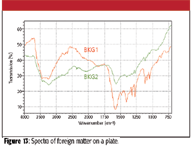
Figure 13
A spectrum search conducted for the red line spectrum in Figure 13 (BKG 1) revealed the substance to be sodium lactate.
ATR Method
The ATR technique is very simple and requires almost no sample pretreatment. There are, however, several important precautions that will lead to better results.
Residual Substance on Prism
In analysis using the IR microscope ATR method, the sample is tightly pressed against the prism. So, before analyzing a sample, check for any residual sample substance that might have been transferred previously to the prism and clean it off. This operation flow is illustrated in Figure 14.
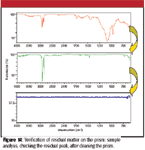
Figure 14
After conducting background measurement, sample measurement is conducted with the sample pressed against the prism. Then the sample and prism are separated and the spectrum is checked using monitor-measurement. If no peaks are seen, as shown in the bottom spectrum of Figure 14, analysis can progress to the next sample because there is no residual substance on the prism. However, if peaks are seen, as shown in the middle spectrum of Figure 14, this indicates the presence of residual substance due to sample transfer to the prism. Consequently, the surface of the prism must be cleaned.
If the sample consists of a mixture of substances, it is possible that only one of the substances from the mixture is stuck to the prism. Very detailed information might be obtained by measuring the transferred spectrum. For example, if the foreign matter includes oil, measurement will provide a spectrum of both the foreign material and the oil. But after separating the prism from the sample, only the oil spectrum will be obtained. Calculating a subtraction spectrum (subtracting the residue spectrum from the spectrum measured in the contact state) will produce a spectrum of the foreign material alone.
Sample Surface Condition and Contact Position
Measurement using the IR microscope ATR technique requires that the sample and the prism contact one another closely. This might not yield a good spectrum, depending on the condition of the sample surface and the contact position. Depending on the position, an irregular sample surface, as shown in Figure 15, might not produce a spectrum.
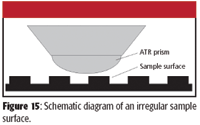
Figure 15
Figure 16 shows an example of IR microscope ATR analysis of dirt stuck to a metal surface. In the figure, peaks can be identified in the blue spectrum (blue-outlined area in the photo), but no distinct peaks are obtained in the red and green spectra. This is because it is very difficult to obtain good contact with those areas, or because the adhering material in those areas is very thin. When no distinct peaks are obtained, it is necessary to change the measurement position.
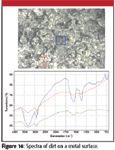
Figure 16
Pressing Force
When using the IR microscope ATR technique, the spectrum might change according to the force with which the sample is pressed against the prism. Soft samples require particular care. Consider the situation in which a multilayer soft sample is measured, as illustrated in Figure 17.
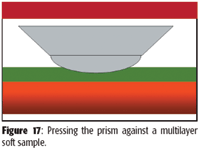
Figure 17
When lightly pressed, a spectrum is obtained only for the green layer in Figure 17. But as the pressing force is gradually increased, the green layer is gradually stretched thin and the spectrum of the red layer is superimposed on the green layer. An example is shown in Figure 18. The spectra correspond to pressing force in the order of A < B < C.
It is evident that as the pressing force increases, a peak became evident in the vicinity of 1650 cm–1, and conversely, the peaks in the vicinity of 1700 cm–1 and between 1250 and 1000 cm–1 became weaker. The most superficial layer corresponds to the spectrum A in Figure 18, and the compounds in the lower layer can be obtained by calculating the subtraction spectrum between spectra C and A.
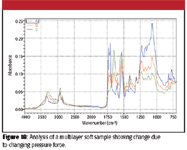
Figure 18
From the resulting subtraction spectrum, the most superficial layer was identified as urethane and the inner layer as an amide compound.
Summary
There are three primary measurement techniques for obtaining IR microscope spectra: transmission, reflection, and ATR. By employing careful sampling and microscope techniques and following a few common best practices, researchers will gain the most accurate and useful data from their equipment.
Sachio Murakami is with the Shimadzu Analytical Applications Dept.
This article is based on information from Shimadzu's FT-IR TALK LETTER, Volumes 5 and 6.
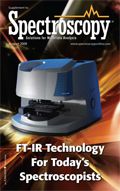
AI Shakes Up Spectroscopy as New Tools Reveal the Secret Life of Molecules
April 14th 2025A leading-edge review led by researchers at Oak Ridge National Laboratory and MIT explores how artificial intelligence is revolutionizing the study of molecular vibrations and phonon dynamics. From infrared and Raman spectroscopy to neutron and X-ray scattering, AI is transforming how scientists interpret vibrational spectra and predict material behaviors.
Real-Time Battery Health Tracking Using Fiber-Optic Sensors
April 9th 2025A new study by researchers from Palo Alto Research Center (PARC, a Xerox Company) and LG Chem Power presents a novel method for real-time battery monitoring using embedded fiber-optic sensors. This approach enhances state-of-charge (SOC) and state-of-health (SOH) estimations, potentially improving the efficiency and lifespan of lithium-ion batteries in electric vehicles (xEVs).
New Study Provides Insights into Chiral Smectic Phases
March 31st 2025Researchers from the Institute of Nuclear Physics Polish Academy of Sciences have unveiled new insights into the molecular arrangement of the 7HH6 compound’s smectic phases using X-ray diffraction (XRD) and infrared (IR) spectroscopy.